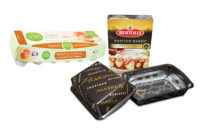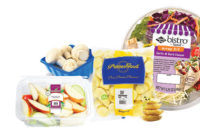Market Trends: Meat/Poultry/Seafood
Meat packaging innovations get cooking
Consumers seek convenience with a side of sustainability.

Ovenable packaging allows consumers to buy, store and cook seafood in one package.

New barbeque bags from Sirane can go right on the grill for easy, no-mess preparation.

Salmon packaging developed by Nofima keeps fish fresh for up to 20 days. Image- ©Vartdal Plastindustri ASOK

Placon has redesigned their classic rotisserie chicken package to reduce use of petroleum-based resins.




For consumers, convenience is the main dish when it comes to meat, poultry and seafood packaging. These perishable foods require careful handling and precise preparations in order to avoid food-borne illness and ensure top notch flavor. Today’s consumers lead fast-paced lives so they look to packaging to solve the problems of shelf-life and food preparation. They also expect these packaging innovations to be as sustainable as possible so that more convenience doesn’t have to mean more waste.
Fish packs go from freezer to feast
Oven Ease® ovenable family of Sealed Air Cryovac® brand food packaging products presents a new option for consumers who want to safely and efficiently cook seafood. OvenEase packaging for frozen seafood enables consumers to purchase seafood items, store them in their home freezer and cook them from their raw state in the oven-ready package. According to the 2013 Power of Meat Report, published by the American Meat Institute and the Food Marketing Institute and sponsored by Sealed Air’s Cryovac brand, less than one-third of consumers indicate a high comfort level in knowing how to prepare fish and seafood.
“Cryovac Oven Ease for seafood enables seafood processors to remove the guesswork from home cooking by providing them the opportunity to develop products that can be seasoned or marinated prior to packaging, with simple preparation instructions included on the products’ exterior package,” says Don Smith, director of marketing for poultry and seafood, Sealed Air’s Cryovac brand.
Convenience is further enhanced by Cryovac brand technology that ensures seal reliability, a critical factor in eliminating messy oven-splatter. The Oven Ease packaging for seafood protects the product from store to freezer to oven and even offers a longer holding time, keeping items hot in the package long after being removed from the oven.
Packaging has barbeque in the bag
While ovenable packaging continues to improve, Sirane is looking to expand its scope of cook-in-package offerings with the Sira-Cook Barbecue Bag. This bag allows consumers to toss the food, package and all, onto the barbecue for easy, mess-free preparation. The bag works for meat, fish, poultry and vegetables. It comes in a number of sizes and in standard and non-stick versions. The top offers a clear panel so users can see the contents being cooked.
“This product has been designed with input from retailers, who told us they wanted to see this product – a cooking bag capable of withstanding direct heat from flames,” says Jeremy Haydn-Davies, sales director for food packing at Sirane. “Imagine a retailer being able to sell a steak with a sauce inside a bag that the user will be able to cook directly on a barbecue – that’s what the Barbecue Bag will offer. The bag can simply be folded over by the user, or heat-sealed as a retail pack.
This would allow over-the-counter sales of ready-to-barbecue packs, which are leak-proof.”
Science helps stock up on “Superfresh” salmon
Consumers want fresh food, but constant stops at grocery markets do not always fit into busy lifestyles. Packaging can solve this by offering a longer shelf life for fresh foods so consumers can make fewer trips to the store. Nofima Mat , the Norwegian Institute of Food, Fisheries and Aquaculture Research, has created a packaging method that keeps salmon fresh for up to 20 days. Superfresh, as the packaging is called, is Modified Atmosphere Packaging (MAP) that places the salmon on a CO2 emitter consisting of baking powder and citric acid, among other things. It is then packed so that air is removed before sealing.
“After the pack is sealed, the cushion develops CO2 gas and it also has absorbent properties. This CO2 emitter has been adapted for the product, so that it does not change the fish’s pH value, and sensory tests have also shown that the fish often has a higher quality than with comparable packaging methods,” says Marit Kvalvåg Pettersen, senior research scientist at Nofima.
The consumer packaging is ready for market, but transport packs are still being developed. This new method offers sustainability in addition to extended shelf life as it requires less volume and the product can be transported with other food.
Rotisserie packs reduce resin reliance
Placon’s patented two-piece container for rotisserie chicken has reduced the use of petroleum-based resins. Placon has replaced the petroleum-based, virgin material with the chemically-inert, food-safe filler, calcium carbonate, which is commonly used in polypropylene food packaging containers due to its numerous beneficial attributes. They have reengineered the packaging using this calcium carbonate filler in the container’s base.
“Sustainability is, and will continue to be, a large driver of food packaging choices for today’s eco-conscious consumer and retailer,” says Jeff Lucash, director of sales - stock products. “Companies are continuously in the market for packaging that meets a number of important criteria – from being functional to having shelf impact all while meeting sustainability objectives.”
Lucash adds that Placon was careful throughout their development process not to sacrifice the visual appeal or structural integrity of the package.
All of these packaging innovations work to accommodate consumer lifestyle needs as well as retailer and food packagers’ desires to create the most sustainable, convenient and effective packaging possible for the meat, seafood and poultry market.
 Meat snacks go for a dip
Meat snacks go for a dip
Jack Link’s has created Big Dippers, an offering that marries the brand’s meat snacks with conveniently packaged dipping sauces. Big Dippers provide meat snack lovers with three flavor pairings in a portable package for easy, on-the-go snacking.
“Big Dippers are a unique product in the smarter snacking universe,” says Jeff LeFever, vice president of marketing at Jack Link’s. “Each package pairs America’s favorite Jack Link’s meat snacks with an enticing sauce in a separate dipping cup, giving consumers a boost of protein with even bigger flavor.”
Big Dippers meet a growing need for hungry consumers with busy lifestyles with an innovative on-the-go tray package. Recent trends indicate that hearty, satiating snacks are an increasingly important part of the average American’s eating habits. In 2012, Technomic, a leading food industry research firm, surveyed 1,500 consumers to gain insights about snacking occasions. According to the survey, nearly half of all respondents (48%) said they snack at least twice a day.
Furthermore, 66% of those polled reach for snacks when they are hungry and it’s not time for a full meal (1).
1. Technomic’s Snacking Occasion Consumer Trend Report, March 2012
Looking for a reprint of this article?
From high-res PDFs to custom plaques, order your copy today!













